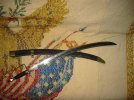Hello
I have partially soaked two of my antique sword blades in Evapo-Rust to free them from surface rust. After 3 hours it has "etched" a line in the blade where the water line was.
Had no idea that Evapo-Rust would be such aggresive to bare metal because it's stated to be a very safe rust remover.
On the first blade the line is near the tip and very deep. Much deeper than the decorative etching itself.
The line on the second blade is near the ricasso and it's more superficial, only about 1/2 thickness of the decorative etching.
I also did a flex test to the first blade on both sides and it did return to true.
Although the the flex test was succesful, I'm still worried to have ruined these blades. They were made to a high sandard and are desirable antiques.
Will these lines act as stress risers or are they too shallow to have any significance? Does the decorative etching cause stress by itself or even more than the line on the second blade, because it's deeper?
Here are the images:
I have partially soaked two of my antique sword blades in Evapo-Rust to free them from surface rust. After 3 hours it has "etched" a line in the blade where the water line was.
Had no idea that Evapo-Rust would be such aggresive to bare metal because it's stated to be a very safe rust remover.
On the first blade the line is near the tip and very deep. Much deeper than the decorative etching itself.
The line on the second blade is near the ricasso and it's more superficial, only about 1/2 thickness of the decorative etching.
I also did a flex test to the first blade on both sides and it did return to true.
Although the the flex test was succesful, I'm still worried to have ruined these blades. They were made to a high sandard and are desirable antiques.
Will these lines act as stress risers or are they too shallow to have any significance? Does the decorative etching cause stress by itself or even more than the line on the second blade, because it's deeper?
Here are the images:
Last edited:

